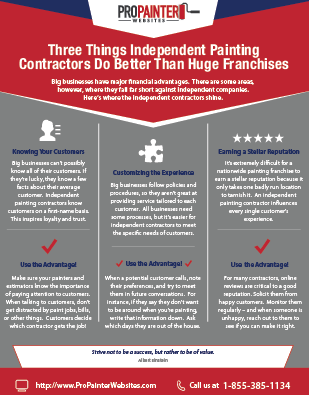Recognizing Seasonal Influences On Commercial Outside Painting: Essential Expertise For Success
Recognizing Seasonal Influences On Commercial Outside Painting: Essential Expertise For Success
Blog Article
Produced By-Leach Rosendal
When you're planning an industrial exterior painting job, seasonal factors can make or break your outcomes. You'll intend to consider just how temperature level and humidity effect paint application and drying times. Choosing the best period can ensure your paint adheres appropriately and lasts much longer. However which seasons are genuinely the best for this kind of work? Let's check out the crucial elements that can influence your job's success.
The Impact of Temperature Level on Paint Application
When you're planning a commercial external painting job, the temperature can substantially impact just how well the paint adheres and dries out.
Ideally, you wish to repaint when temperatures range between 50 ° F and 85 ° F. If it's as well cold, the paint might not treat effectively, causing problems like peeling off or splitting.
On the other side, if it's as well hot, the paint can dry out as well swiftly, stopping proper bond and leading to an irregular coating.
You need to likewise think about the time of day; morning or late afternoon supplies cooler temperatures, which can be much more desirable.
Always check the supplier's recommendations for the details paint you're making use of, as they typically offer advice on the suitable temperature level range for optimum results.
Humidity and Its Impact on Drying Times
Temperature level isn't the only environmental factor that influences your business exterior paint job; humidity plays a considerable duty as well. High humidity degrees can reduce drying out times considerably, impacting the overall quality of your paint job.
When the air is saturated with wetness, the paint takes longer to cure, which can cause concerns like poor bond and a greater danger of mold development. If https://thehill.com/blogs/in-the-know/3547356-norman-rockwell-paintings-being-removed-from-the-white-house-report/ on an especially moist day, be prepared for extensive wait times in between layers.
It's crucial to check local weather and plan appropriately. Preferably, go for humidity levels in between 40% and 70% for optimum drying out.
Keeping these factors in mind ensures your task remains on track and supplies a lasting finish.
Best Seasons for Commercial Exterior Painting Projects
What's the most effective season for your commercial exterior paint projects?
Spring and early autumn are commonly your best bets. During these periods, temperature levels are light, and humidity levels are frequently lower, producing ideal problems for paint application and drying out.
Prevent summer season's intense heat, which can cause paint to dry too swiftly, resulting in inadequate adhesion and finish. In a similar way, wintertime's chilly temperatures can hinder correct drying and treating, running the risk of the long life of your paint task.
Aim for days with temperatures in between 50 ° F and 85 ° F for optimal results. Remember to check the local weather prediction for rainfall, as damp problems can spoil your project.
Planning around these variables ensures your painting task runs efficiently and lasts longer.
Conclusion
To conclude, preparing your business external painting tasks around seasonal factors to consider can make a considerable difference in the outcome. By organizing work during the optimal temperatures and humidity levels, you'll ensure much better bond and drying out times. Keep in click for more to keep an eye on regional weather prediction and select the correct time of year-- springtime and very early fall are your best options. Taking these steps will certainly aid you attain a long lasting and professional coating that lasts.
